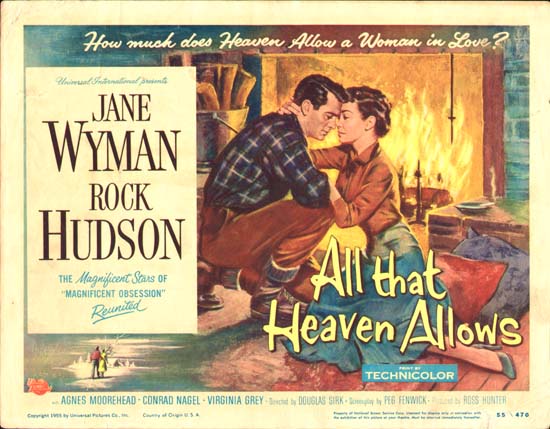 |
Blackboard Jungle (1955) Bryan Keefer, Savanna Melton, & Holland Millure |
The movie Blackboard Jungle is a social commentary produced in 1955 that
became a blockbuster hit of the year. This movie focused on the growing problem
of teenage delinquency, especially in inner city schools. It concentrations on
a new teacher in an all-boys school that has a terrible reputation for gang
crime and misbehavior among the students. Blackboard
Jungle tackles issues such as the delinquency problem as well as race, the
generation gap post WW11, and more controversial issues such as miscarriage.
The movie uses the context of the school to address all of these issues and
directs their message to both adults (parents) and teenagers through different
mediums, such as the music used and topics handled. Through the development of
the plot and the interactions between the characters (teachers and students)
the movie makes it clear that adults need to be committed to helping these
teens to deal with all of these problems. The movie was received well by both
adults and teens, but many feared that the problems talked about were more widespread
than just in inner city school systems. Some cities found this movie to be too
controversial, either refusing to show it or cut certain scenes that had the
rock music played because they feared it would incite violence among teens
after seeing the movie.
The
main purpose of Blackboard Jungle is
to inform and shock the public about the problems of juvenile delinquency and
America’s failing public schools. Apart from the fact that the students are
portrayed as criminals, they also appear disrespectful to adults and
unmotivated in school. North Manual High School is an urban multiethnic
vocational school, and the problems the school faced are mentioned and implied
on many occasions. The film also reflects issues due to the generation gap. The
teachers often discuss how they do not understand and cannot control the
students, while the students constantly victimize the older generation. The
film also puts on display the norm of rock ‘n’ roll, the music genre that was
gaining significant popularity at the time, particularly among the younger
generation. Teenagers danced in the aisles of the theaters as “Rock Around the
Clock” by Bill Haley and His Comets played in the opening and closing credits,
leading some theaters to mute the song. Blackboard
Jungle is known for marking the emergence of rock ‘n’ roll in mainstream
culture. One can definitely see the film as realist, as it depicts the actual
problems many American schools were facing in the postwar era, but, on the
other hand, it can be interpreted as a sensationalist exaggeration of the
school problems and the overall danger of the newly emerging youth culture.
Unlike other movies we have reviewed Blackboard Jungle was a
social commentary and so it directly addressed the issues it saw in society
without the use of analogies like other films, such as Invasion of the Body
Snatchers. One similarity, however, is the gender role conformity that’s seen
through Mrs. Dadier, being a “perfect wife” like the mother in “Leave it to
Beaver!,” as well as through Mrs. Hammond, who is condemned for her promiscuity
like the gypsy in Oklahoma!. Other connections are with respect to the article,
“Yakety Yak, Don’t Talk Back.” Problems brought up that are addressed in the
movie include the generation gap, inner city communities, concerns with rock
‘n’ roll and for a correct way to discipline teenagers. The main article and
the movie mostly focus on the influences of rock ‘n’ roll to have teenagers
reject adult authority and the correct way to discipline. The movie “demonstrates”
the fears addressed in the article that rock ‘n’ roll does cause teenagers to
rebel against authority, including teachers, conform to peer-norms (of gang
violence in this case), and become hypersexual while and after listening. The
movie also addresses with the difficulties of disciplining and getting the
correct response needed from the teenagers after the punishment has been given.
Sources
Bosley
Crowther, “The Screen; ‘Blackboard Jungle’; Delinquency Shown in Powerful
Film,” New York Times, March 21, 1955, accessed February 25, 2015, http://www.nytimes.com/movie/review?res=9803E1DE153EE53ABC4951DFB566838E649EDE.
“Blackboard
Jungle,” http://en.wikipedia.org/wiki/Blackboard_Jungle.
Encyclopaedia
Britannica Online, s.v. “Blackboard Jungle,” accessed February 25, 2015, http://academic.eb.com.pitt.idm.oclc.org/EBchecked/topic/1346766/Blackboard-Jungle.
Adam
Golub, “They Turned a School into a Jungle! How the Blackboard Jungle Redefined
the Education Crisis in Postwar America,” Film
& History 39 (2009), accessed February 25, 2015, https://www.questia.com/read/1P3-1883667851/they-turned-a-school-into-a-jungle-how-the-blackboard.
Kevin
E. McCarthy, “Juvenile Delinquency and Crime Theory in Blackboard Jungle,” The
Journal of Criminal Justice and Popular Culture 14 (2007), accessed
February 25, 2015, http://www.albany.edu/scj/jcjpc/vol14is4/McCarthy.pdf.







